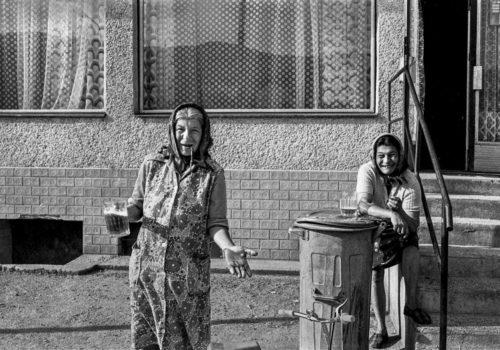Their names are Marie-José and Claude Carret. They are married. They are photographers. For 30 years, they have traveled across Europe to meet the Roma.
“Neither Marie-Jo nor myself were predestined to give so much importance to photography. The gaze has become the very essence of our existence.”
No need to distinguish between the photos of the Carret couple in order to know which of the two took which photo. Their work is in symbiosis, they complement each other. As photographers, they are discreet. They first try to create a closer relationship, the camera staying away.
Thanks to their approach, the people presented in the photos are relaxed and spontaneous. Many shots reflect the naturalness and lightness with which the moment was captured.
The Carrets met the first Roma family in 1984 in Klenovec (a village in present-day Slovakia). At that time, they had arrived in Czechoslovakia without (having) a precise plan.
They wanted to photograph the country in its entirety, therefore the landscape, the traditions, but also the minorities because they already had experience in this field, having done a project with political refugees from Laos and Cambodia living in Brittany. From the first contact with the Roma in Slovakia, the Carrets moved to Klenovec two or three times a year for the next 10 years.
These unknown French people at first became friends and the inhabitants began to invite them to weddings, parties, communions, funerals…
The imaginary door opened and they could glimpse ceremonies and rituals, where, apart from the often attractive visual appearance of things on the surface, their essence was also revealed. Gradually, people shared with them intimate feelings and moments of family life as well as their personal piety. Each time, the Carrets brought back the photographs. Very quickly, they became “memory smugglers” of the inhabitants of the village who had already passed away. In this way, the Carrets entered the consciousness of the community visited.
Over the following years, the Carret couple’s interest in Roma life and culture did not wane. Quite the contrary. In 1994 they decided to also get to know the culture in other countries. They began to go to the Roma in Hungary, Romania, Moldova, and then to Yugoslavia and Ukraine. By documenting sub-ethnic groups from Kalderare, Gabori and Lovars in Romania, they established contact with Roma throughout the country.
Their photographic approach has nevertheless remained the same: an intimate relationship with the people photographed, sharing, recording ordinary and festive moments of life. As the Carrets make clear when describing their work, they do not seek to idealize the Roma through their photographs. Rather, they want to break the stereotypical clichés that put them on the margins of society. They look for traits common to particular cultures, it is possible to find them in everyday life with its almost imperceptible poetry, as well as in sacred and ceremonial life.
Adam Holubovsky, Eva Mazarova
















